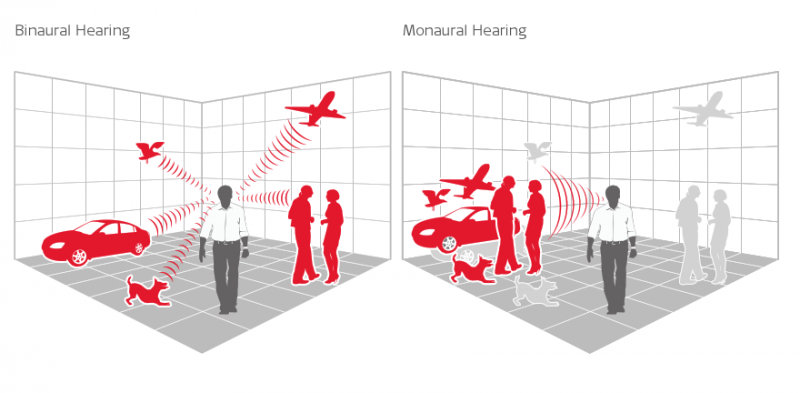Binaural Hearing: Cochlear Implants & Single-Sided Deafness

Hearing loss in just one ear—known as unilateral hearing loss (UHL) or single-sided deafness (SSD)—is surprisingly common. Today, we’re going to look at why it’s so important to hear with both ears. This in-depth article is slightly longer than usual, but we’ve got a great video with 3D audio to help you understand the benefits of binaural hearing.
Often, individuals with single-sided deafness have nearly normal speech understanding in quiet. This can give friends & family the impression that single-sided deafness is only a minor issue. However, single-sided deafness has a significant impact on quality of life, and should be recognized as serious burden on individuals affected.
In everyday noisy settings, speech can be very difficult to understand with only one hearing ear. Sounds from the side with hearing loss are significantly muffled by the “head shadow” effect. Unilateral hearing loss also makes it very challenging, if not impossible, to tell where sounds are coming from.1
- Difficulty understanding speech in noise
- Can’t tell where sounds are coming from
- Increased listening effort
- Anxiety in busy or noisy places
- Difficulties at work and social gatherings
Imagine struggling to follow conversations at work, or always having to turn your ear to understand a friend, or worrying that you won’t notice sudden warning noises when crossing the street. Even with “one good ear”, everyday life with single-sided deafness can be exhausting.
Today, we’re going to look at how cochlear implants can help to restore binaural hearing—hearing with both ears—making them an ideal treatment option for single-sided deafness. This introduction to binaural hearing is the beginning of our series on single-sided deafness & cochlear implants. Later in this series, we’ll go into the details of how a cochlear implant can significantly improve speech understanding, make listening easier, and effectively help to restore sound localization.1
Monaural Treatment Options for Unilateral Hearing Loss
Currently, there are several treatment options for single-sided deafness. Let’s start with the monaural options, which utilize only one hearing ear. Essentially, with monaural solutions, sounds from both sides are being added together and presented to the hearing ear.
CROS hearing aids send sounds from a microphone on the deafened side to a hearing aid in the hearing ear. Bone conduction implants use an implant & audio processor on the deafened side to send sounds through the head to the functional cochlea on the hearing side.
These systems are able to reduce the head shadow effect by providing sounds from both sides of the head. This can provide improved speech understanding and greatly improve awareness of sounds from all sides.2
However, these monaural treatment methods can have several disadvantages. Sound localization is generally not improved, because the ability to hear where a sound is coming from relies on binaural input from both ears—including both cochleae.3,4 Furthermore, background noise picked up from the microphone on the deafened side and routed to the hearing ear can reduce speech understanding if noise is presented on the deafened side.1,4,5,6
Cochlear Implants for Single-Sided Deafness
In contrast to monaural solutions, a cochlear implant can help to restore binaural hearing—that is, hearing with both ears. By bypassing the non-functioning hair cells in the affected cochlea, a cochlear implant can help to restore hearing to the deafened ear. With two hearing cochleae, a cochlear implant recipient with single-sided deafness can appreciate significant benefits in speech understanding, ease of listening, and sound localization.1,16

Let’s look at how a cochlear implant for single-sided deafness offers improved speech understanding in both quiet and noise.
In noisy environments, the advantages of a cochlear implant for single-sided deafness are especially prominent. With two hearing cochleae, you can experience spatial hearing—hearing in 3D—which helps the brain separate the sounds in a 3D space and selectively process the information. With spatial hearing, there are three main mechanisms for improving speech understanding in noise: binaural summation, the squelch effect, and the head shadow effect.1
Binaural summation: Hearing with both ears provides a louder and more robust sound signal for the brain. This offers a 1–2 dB SNR improvement in noise for both normal-hearing and bilateral cochlear implant listeners, and can reduce listening effort in general.1,7,8,9,10
Squelch effect: By comparing sounds received in both ears, central auditory processing in the brain can improve the quality of a sound and filter out noise. This primarily uses redundant information of the sound as received by the two ears. Even an ear hearing mostly noise will still provide an SNR benefit of ~3 dB in normal-hearing listeners, as binaural listening provides a more complete sound signal for auditory processing.1,11
Head shadow effect: The head is a natural barrier between the ears that muffles higher frequencies (1000 Hz and up) by as much as 20 dB when sounds arriving from the opposite side travel around the head to reach the ear. Without an implant or CROS system, sounds on the deafened side are very difficult to hear.1,12
A CROS or bone conduction system can help to restore sound awareness to both sides, but in settings with background noise, these systems may not always be as advantageous as expected. If noise is presented to the CROS or bone conduction device and speech to the naturally hearing ear, the CROS or bone conduction system would add the noise to the hearing cochlea, creating a significant reduction in speech understanding.1,4,5,6
In contrast, a cochlear implant provides significant benefit in any noise configuration, without the speech understanding reduction seen with CROS . Using two physically separate cochleae allows noise presented on either side of the head to be filtered out using central auditory processing of the brain.
Therefore, a cochlear implant offers significantly better speech understanding in noise than monaural hearing with a CROS or bone conduction system, especially when noise is presented on the implanted side.1,16
What’s the practical benefit of binaural hearing? Check out this simulation we created using 3D binaural microphones to compare single-sided deafness and binaural listening.
Closest to Natural Hearing
The auditory benefits of binaural hearing with a cochlear implant are significantly better than hearing with a CROS or bone conduction system. Therefore, a cochlear implant should generally be the considered the first-choice treatment option for single-sided deafness.1
However, it’s also important to remember that a person with single-sided deafness still has natural hearing in one ear. This makes sound quality an especially important consideration, as a mismatch in sound quality may distort the binaural auditory processing of those sounds in the brain.13
Unlike any other cochlear implant, only a MED-EL cochlear implant can offer a sound quality that is truly the closest to natural hearing.13 This is only possible through the proven combination of atraumatic insertion, electrode arrays that better cover the whole cochlea, and pitch-matched sound coding.
What are the potential benefits of this more natural sound quality for your patients?
- More natural pitch match between ears13
- Better hearing performance 14,15,16
- Quick adaptation 14,15,16
Subscribe & Share
Thanks for checking out our introduction to single-sided deafness & cochlear implants. Next in this series, we’ll be looking at sound localization with binaural hearing and why a natural pitch match is so important with cochlear implants, so stay tuned!
Have a question about cochlear implants for single-sided deafness? Learn more about MED-EL cochlear implants and connect with us for local support and guidance: Cochlear Implants for Single-Sided Deafness
Don’t miss any of our articles—subscribe now!
*Not all products, indications, and features shown are available in all areas. Please contact your local MED-EL representative for more information.
References:
- Mertens G; De Bodt M; Van de Heyning P (2017). Evaluation of Long-Term Cochlear Implant Use in Subjects With Acquired Unilateral Profound Hearing Loss: Focus on Binaural Auditory Outcomes. Ear Hear, 38(1), p. 117-125
- Müller, A., Hocke, T., Hessel, H., & Mir-Salim, P. (2016) Results of speech audiometry testing in case of transcranial CROS depend on duration of deafness. Laryngorhinootologie, 96(5):293-298.
- Peters JP; Smit AL; Stegeman I; Grolman W (2015). Review: Bone conduction devices and contralateral routing of sound systems in single-sided deafness. Laryngoscope, 125(1), p. 218-226
- Arndt S; Laszig R; Aschendorff A; Hassepass F; Beck R; Wesarg T (2017). Cochlear implant treatment of patients with single-sided deafness or asymmetric hearing loss. HNO, 2017 Feb 10 [epub ahead of print]
- Finbow, J., Bance, M., Aiken, S., Guliver, M., Verge, J., & Caissie, R. (2015) A comparison between wireless CROS and bone-anchored hearing devices for single-sided deafness: A pilot study. Otol Neurotol., 36(5):819-825.
- Kitterick PT; Smith SN; Lucas L (2016). Hearing Instruments for Unilateral Severe-to-Profound Sensorineural Hearing Loss in Adults: A Systematic Review and Meta-Analysis. Ear Hear, 37(5), p. 495-507
- Bronkhorst AW; Plomp R (1989). Binaural speech intelligibility in noise for hearing-impaired listeners. J Acoust Soc Am, 86(4), p. 1374-1383
- Cox RM; DeChicchis AR; Wark DJ (1981). Demonstration of binaural advantage in audiometric test rooms. Ear Hear, 2(5), p. 194-201
- Müller J; Schön F; Helms J (2002). Speech understanding in quiet and noise in bilateral users of the MED-EL COMBI 40/40+ cochlear implant system. Ear Hear, 23(3), p. 198-206
- Schleich P; Nopp P; D’Haese P (2004). Head shadow, squelch, and summation effects in bilateral users of the MED-EL COMBI 40/40+ cochlear implant. Ear Hear, 25(3), p. 197-204
- Bronkhorst AW; Plomp R (1988). The effect of head-induced interaural time and level differences on speech intelligibility in noise. J Acoust Soc Am, 83(4), p. 1508-1516
- Shaw EA (1974). Transformation of sound pressure level from the free field to the eardrum in the horizontal plane. J Acoust Soc Am, 56(6), p. 1848-1861
- Rader, T., Döge, J., Adel, Y., Weissgerber, T., & Baumann, U. (2016). Place dependent stimulation rates improve pitch perception in cochlear implantees with single-sided deafness. Hear Res., 339, 94–103.
- Buchman, C.A., Dillon, M.T., King, E.R., Adunka, M.C., Adunka, O.F., & Pillsbury, H.C. (2014). Influence of cochlear implant insertion depth on performance: a prospective randomized trial. Otol Neurotol., 35(10), 1773–1779.
- O’Connell, B.P., Hunter, J.B., Haynes, D.S., Holder, J.T., Dedmon, M.M., Noble, J.H., Dawant, B.M., & Wanna, G.B. (2017) Insertion depth impacts speech perception and hearing preservation for lateral wall electrodes. Laryngoscope. Epub ahead of print.
- Buss, E., Dillon, M., Rooth, M., King, E., Deres, E., Buchman, C., Pillsbury, H., and Brown, K. (2018) Effects of cochlear implantation on binaural hearing adults with unilateral hearing loss. Trends Hear., 22.
CTA Form Success Message
Send us a message
Field is required
John Doe
Field is required
name@mail.com
Field is required
What do you think?



